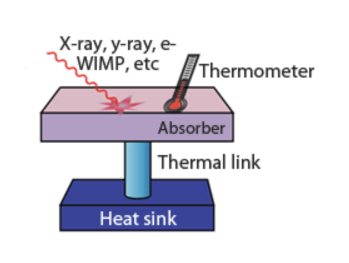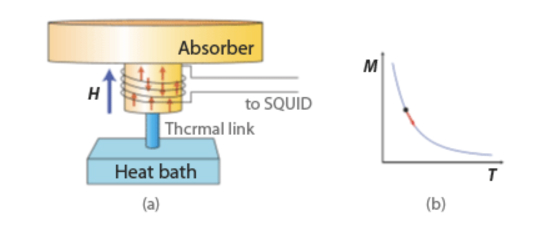Research
Detector Development
What are low temperature detectors?
The major scientific goal of the Center for Underground Physics (CUP) at IBS is based on rare event searches for direction detection of WIMPs and neutrinoless double beta decay. It is very important to develop the detectors sufficient energy resolution and threshold and active background rejection capability for the proposed experiments.
We use cryogenic particle detectors as one of major detections technologies used for the rare event experiments. When a particle interacts with an absorber in solid state, energy transfers to the electrons and nuclei in the material of the absorber. Most of the energy transferred into the absorber is eventually converted into the thermal energy of the solid even in a semiconductor or scintillating absorber. With a suitable thermometer, the energy transfer can be accurately measured.

-
Figure 1 :
Detection concept of cryogenic particle detectors.
How do they work?
Metallic Magnetic Calorimeters (MMCs) are one of the most highly developed thermometers used in cryogenic particle detection. MMCs utilize a paramagnetic material whose magnetization is a function of temperature. A simplified setup of an MMC is illustrated in figure 2. The detection principle of an MMC can be characterized as ΔE > ΔT > ΔM > Δ > ΔV, where E, T, M, Φ and V indicate the physical quantities of energy, temperature, magnetization, magnetic flux and voltage, respectively.

-
Figure 2 (a) :
A simplified MMC setup with an absorber.
-
Figure 2 (b) :
Typical M-T characteristics of an Au:Er sensor in a magnetic field. Energy input into an absorber results in a change in the magnetization of the MMC sensor attached to the absorber.
 Center for Underground
Center for Underground